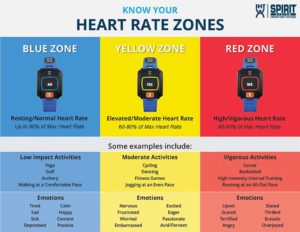Separate six-week heart rate research studies demonstrate that IHT ZONE wrist monitors provide students with essential feedback that motivates them to work hard enough to improve their overall health and fitness during exercise sessions.
The heart rate monitors give students an easy-to-understand view of their PE performance by showing them their actual heart rate and the heart rate zone they are currently exercising in at any given moment.
 The monitor designates heart rate zones by color so young students can begin to learn about moderate-to-vigorous physical activity. The heart rate monitor turns:
The monitor designates heart rate zones by color so young students can begin to learn about moderate-to-vigorous physical activity. The heart rate monitor turns:
- Blue when students are calm or near their resting heart rate;
- Yellow when students have achieved an elevated heart rate with moderate activity; and
- Red when students are exercising vigorously and nearing their maximum heart rate.
University of Nebraska-Kearney student Danielle Tilley’s study showed participants saw a significant difference between the effort they felt they were exerting and what the monitor showed about their actual heart rate.
Tilley’s study included a six-week physical education class in which students completed walk, jog and sprint tests and self-assessed their effort level using the Borg Scale of Perceived Exertion. Once students gave their own assessments, they compared those to the data from the heart rate monitors.
“When you’re not tired, it’s really easy to tell that, and when you’re out of breath, it’s really easy to tell that,” she said before noting the differences in perceived exertion and actual exertion. “But when you’re in between those, it’s hard to tell exactly where you are. They thought they were in better shape than they are.”
Developing an Understanding of MVPA
The students who took part in Tilley’s study left with a key understanding that she hopes will guide them in the future. They learned what it feels like to exercise with moderate or vigorous-intensity – the Centers for Disease Control recommend students complete between 30 and 60 minutes of this exercise every day – by comparing how they felt with the color on the heart rate monitor.
“If they aren’t exercising outside of that (blue zone), then they aren’t really exercising at all,” Tilley said. “That might affect their perception.”
The Council for Undergraduate Research named Tilley a 2018 “Posters on the Hill” winner. Of the 60 winners, Tilley was the only researcher whose study focused on the benefits of physical education. Tilley remains an advocate for IHT’s heart rate technology in PE classrooms.
“The minute the ZONES start flashing, students are running around the gym trying to see who can get into the red zone the fastest,” Tilley said. “They are really good tools, not only for assessment but also for motivation.”
Understanding Heart Rate Technology
Tilley studied under the direction of UN-K Health and PE Program Chair Megan Adkins, who has been a consistent proponent of using technology to connect with PE students. Adkins trains her future PE teachers on IHT’s key components – the heart rate monitors and assessment software – so they have a full understanding of how to teach heart rate.
“I’ve been around the block to know what types of technologies are out there, and this hands-down was the one I was going to go with,” Adkins said. “The capabilities of IHT are not just in the IHT ZONE itself. It’s what it can evaluate. I saw it as an evaluative piece at the collegiate level not only for practical experiences to teach students but also on the teacher side.”
‘A Great Motivating Tool’
In her 2019 heart rate research study, then-Michigan State University graduate student Jeanette Ricci saw first-hand how fourth and fifth-grade students responded when wearing the IHT ZONE heart rate monitors during a High-Intensity Interval Training course.
“Students engaging in the HIIT circuits over the six weeks saw a 7% improvement in cardiorespiratory fitness and a 10% improvement in upper body strength,” Ricci said.
After learning about the IHT ZONE heart rate monitors, Ricci felt they’d mesh well with young students because they deliver data that’s easy to understand.
“The thing that stood out for me was how interactive it is for the kids,” Ricci said. “The heart rate monitors are a fun way to educate students on how they can work at different intensities without throwing all of the technical terms at them, especially applicable to HIIT. Those interval formats do really well having the different colors on the heart rate monitors.”
Ricci said she noticed students focusing on the heart rate monitors and understanding how hard they needed to work to meet goals at specific HIIT stations. The real-time feedback students got while wearing the monitors during class combined with a heart rate summary they received via email after returning the monitors gave them easy-to-understand insight into their performance.
“We tried to encourage them and the monitor was a great motivating tool,” she said. “Kids love seeing the data pop up on their screen after class.”




